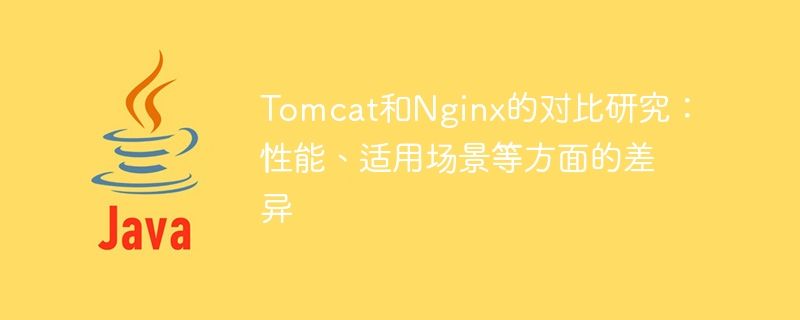Home >Java >javaTutorial >Comparison of Tomcat and Nginx: Research on differences in performance, applicable scenarios, etc.

Comparative study of Tomcat and Nginx: differences in performance, applicable scenarios, etc.
Introduction:
Tomcat and Nginx are two commonly used web servers. It has a wide range of applications in the Internet field. However, there are certain differences in their performance and applicability in different application scenarios. This article will focus on the differences between Tomcat and Nginx in terms of performance and applicable scenarios.
1. Performance comparison study:
1.1 Static resource request performance:
Nginx is more suitable for processing static resource requests than Tomcat. Nginx adopts an efficient event-driven model, which can easily handle a large number of concurrent connections and has excellent performance. As a Java Web server, Tomcat's performance in processing static resources is relatively weak.
1.2 Dynamic resource request performance:
Tomcat has better performance in handling dynamic resource requests. Because its bottom layer is coded in Java, Tomcat can handle complex dynamic resource requests, such as JSP, Servlet, etc. Although Nginx supports dynamic processing such as FastCGI and PHP, its ability to handle dynamic requests is limited compared to Tomcat.
1.3 High concurrency performance:
In the case of high concurrency, Nginx’s performance is even better. Due to Nginx's event-driven model and efficient multi-thread processing mechanism, it can handle a large number of concurrent requests with low latency. Tomcat, on the other hand, has relatively poor performance under high concurrency conditions.
2. Comparative study of applicable scenarios:
2.1 Static website:
For application scenarios of static websites or resource file storage and transmission, Nginx is an ideal choice. Due to its efficient performance and extremely low resource usage, Nginx can easily handle a large number of static file requests.
2.2 Dynamic website:
Tomcat has more advantages in application scenarios that need to handle complex dynamic requests. Because it supports Java programming, Tomcat can handle tasks such as interacting with databases and dynamic page generation. For dynamic websites that need to be developed using JSP, Servlet and other technologies, Tomcat is the first choice.
2.3 Load balancing:
In a load balancing scenario, Nginx can distribute requests to multiple backend servers through reverse proxy, IP hashing and other mechanisms to achieve load balancing requirements. Tomcat is mainly used as an application server and cannot directly implement load balancing functions. Usually when implementing load balancing, Nginx and Tomcat are used together.
3. Differences in other aspects:
3.1 Deployment complexity:
Relatively speaking, Nginx deployment is simpler than Tomcat. Nginx only needs to configure some basic instructions and parameters to build a basic web server. Tomcat requires tedious work such as Java environment configuration and a series of Web application deployments.
3.2 Memory consumption:
Since Tomcat is a Java-based web server, its memory consumption is relatively high. Nginx is developed using C language and takes up less memory.
Conclusion:
To sum up, there are certain differences between Tomcat and Nginx in terms of performance and applicable scenarios. Nginx is suitable for handling static resource requests, load balancing and other scenarios, while Tomcat is better at handling dynamic requests and dynamic website development. In practical applications, by combining the advantages of Nginx and Tomcat, various needs can be better met.
The above is the detailed content of Comparison of Tomcat and Nginx: Research on differences in performance, applicable scenarios, etc.. For more information, please follow other related articles on the PHP Chinese website!